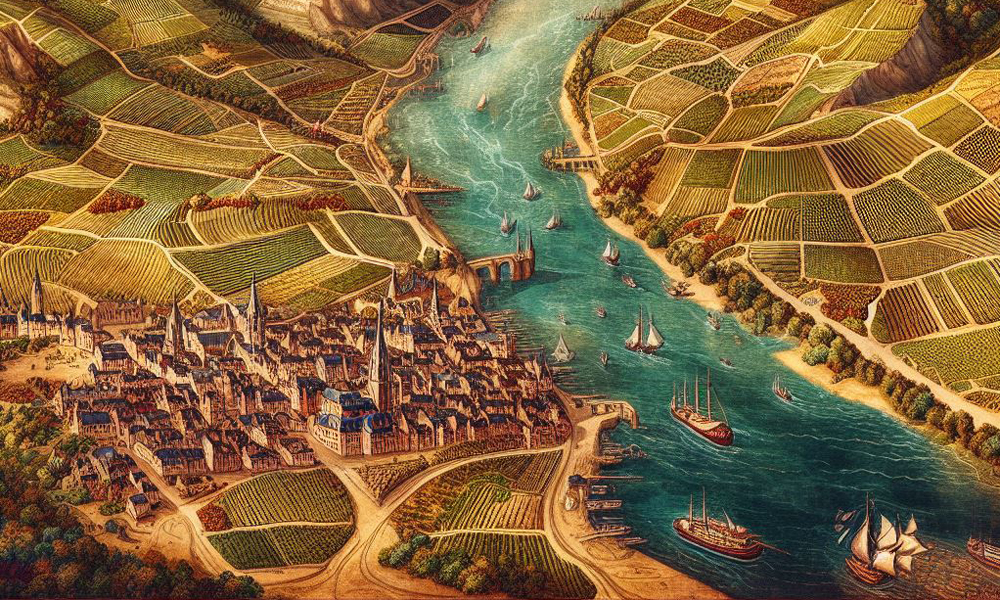- Wine Color/Type
- Top Occasions
- Unique Wines
- Surprise Me!
It's All About the Vintage - Part 3-2 Burgundy
Meet the Best Burgundy Vintages
In the previous parts of this series we explored why vintage is important when selecting wines. Now it’s time to find out more about the excellent Burgundy vintages!
Find the first part of this series here!
The vintages are viewed holistically. However, each subregion in Burgundy has its unique attributes. (Credit: DallE)
The oldies
Emerging from the shadows of World War II, the wines of 1945 carry historical weight. Despite the hardships leading up to this year, the climatic conditions like in Bordeaux were near-perfect, with a warm, dry summer ensuring optimal ripening. The resultant wines were deeply concentrated, mirroring the intensity of a world recovering from conflict. They remain emblematic of resilience and rejuvenation.
The 1959 vintage was graced with a long, hot summer, leading to an early and abundant harvest. The wines were voluptuously rich and opulent, capturing the essence of a golden era. With pronounced fruitiness and a velvety texture
After a challenging start in 1978 with a wet spring, the weather took a turn for the better, gifting Burgundy with a dry, warm summer and an impeccable harvest. The wines were structured, with a beautiful interplay of acidity and fruit. For many wine connoisseurs, the reds from this year stand as benchmarks of Burgundy's prowess in expressing terroir.
1985 was a harmonious year in terms of climate. A consistently warm growing season without any major disruptions led to balanced, elegant wines. They were accessible in their youth yet had the backbone for long aging, reflecting Burgundy's dual charm of immediacy and longevity.
The following standout vintage of 1990 was blessed with consistent warmth and optimal rains. The grapes reached full maturity, yielding wines that were powerful, concentrated, and brimming with character. These wines, while exquisite in their youth, have evolved gracefully, showcasing the depth Burgundy offers.
The end of the millennium saw a generous harvest in 1999 following favorable weather conditions. The wines were fruit-forward, with a delightful vibrancy and depth. They encapsulated the essence of Burgundy – a perfect blend of tradition and modernity.
A new generation of winemakers is producing outstanding vintages almost every year. (Credit: DallE)
A new Millenia
As the 20th century gave way to the 21st, Burgundy entered a transformative era, characterized not only by the touch of modernity but also by nature's increasing unpredictability. The new millennium brought with it advancements in viticulture and winemaking, along with challenges posed by climate change. Yet, amidst these changes, Burgundy has consistently showcased its resilience and artistry, producing vintages that oscillate between opulent warmth and structured elegance. The past two decades have underscored Burgundy's enduring appeal—its ability to capture both the essence of its storied terroir and the nuances of each passing year.
2005 was a vintage that many wine enthusiasts and critics alike remember with reverence, and stands as a testament to Burgundy's grandeur. The weather gods were benevolent, providing a cold winter to rest the vines, a spring that was dry and sunny, leading to excellent flowering, and a summer that was consistently warm without crossing into the extremes. The result? Wines that were deeply concentrated, structured, and brimming with potential longevity. The Pinot Noirs were especially compelling, showing layers of dark fruit, forest floor, and fine-grained tannins. Even today, they continue to evolve, promising further complexity for those with the patience to wait.
Often heralded as the year of opulence, 2009 in Burgundy was marked by generous sunlight and warmth. Grapes reached optimal ripeness, yielding wines that resonated with lush fruitiness, velvety textures, and immediate appeal. While these wines were more approachable in their youth compared to the more structured 2005, they also showcased an underlying depth and structure hinting at their aging potential. Chardonnays from this year were particularly charming, exuding tropical notes juxtaposed with Burgundy's quintessential minerality.
The narrative of 2010 is one of contrasts, especially when juxtaposed against the warmth of 2009. Cooler temperatures prevailed, and the yields were notably smaller. However, adversity sometimes breeds excellence. The wines from this year are a paragon of elegance, high acidity, and profound depth. The Pinot Noirs, in particular, are a masterclass in balance—fragrant, vibrant, and endlessly complex. The whites, too, stood out with their crystalline purity and precision.
In 2012, Burgundy faced the whims of nature—frost, hail, and a generally cooler summer. Such challenges inevitably reduced the yields. Yet, the essence of winemaking is to find beauty in adversity. The wines, despite being fewer in quantity, were rich in character—concentrated, nuanced, and reflective of their terroir. It’s a vintage that reminds us of nature's unpredictability and the winemaker's artistry in harnessing it.
The allure of 2015 lies in its harmonious blend of warmth and restraint. The year saw ample warmth, reminiscent of 2009, but with a touch more composure. The resultant wines are aromatic, multi-layered, and finely structured. The reds from Côte de Nuits are particularly stellar, showcasing ripe berries, supple tannins, and an underlying earthy complexity. Meanwhile, the whites from Côte de Beaune offered a delectable interplay of fruit, acidity, and minerality.
After facing several years of climatic challenges and reduced yields, 2017 emerged as a breath of fresh air for Burgundy. The vintage was generous in terms of volume, and the wines, though perhaps not as profound as the 2005s or as structured as the 2010s, were brimming with freshness, charm, and aromatic appeal. They serve as a delightful testament to Burgundy's versatility, offering pleasure in their youth while still holding the promise of maturity.
While still relatively young, early whispers and tastings suggest 2019 could ascend to the pantheon of legendary vintages. Despite facing heatwaves, the resilient Burgundian vines produced grapes of exceptional quality. The wines, from initial tastings, exhibit concentration, balance, and an arresting aromatic profile—a harmonious blend of fruit, terroir, and artistry. Only time will reveal their true stature, but the anticipation is palpable.
This concludes the second part of our series on the vintages of Burgundy. Click here to delve deeper into how vintages specifically affect Burgundy wines. In the next article we will be looking at the lesser vintages of Burgundy.
Peter Douglas
Latest articles


